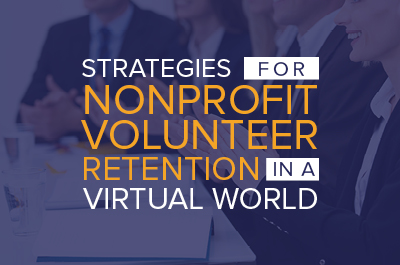Donor retention gets a lot of attention, and with good reason. Generally, the average nonprofit retention rate has hovered around 40% for years. However, when you increase that rate by simply 10% (or hopefully more), you can raise tens of thousands of dollars more at your organization.
Similarly, when you engage and retain volunteers, you’ll save money on recruitment and training activities for the future, helping you focus more intently on your mission.
The first step to increasing your volunteer retention rate is showing your appreciation appropriately to those who engage with your organization and contribute to your success.
This will help you develop effective and beneficial relationships between your organization and your valuable supporters. Luckily, there is a lot of overlap between the strategies that help retain donors and the strategies that help retain volunteers. At the end of the day, supporters of every kind want to be recognized, appreciated and engaged.
Here at Bloomerang, we designed our nonprofit software solution with retention in mind. We help thousands of nonprofits improve their retention rates by developing strong relationships with supporters every day. From our ample experience, we’ve developed a list of appreciation strategies that your organization can employ to cultivate your relationship among volunteers.
Without further ado, let’s dive into some volunteer appreciation and stewardship ideas that can help you develop relationships and improve your retention rates.
1. Provide Non-Traditional Volunteer Activities

Social distancing may have limited your ability to host in-person volunteers. But beyond the pandemic, you may have supporters who love you but don’t live near your office or service area, or who are unable to help in-person due to a disability. In any case, it’s a good idea to have virtual volunteer opportunities so that all of that passion doesn’t go under-leveraged.
There are many ways for volunteers to help out from the comfort and safety of their own home. Consider, for instance, the following merchandise ideas:
- Peer-to-Peer Fundraising. Encouraging supporters to leverage their networks to create new donor opportunities is a high-value activity with a low cost of donor acquisition. For example, if you have birthday data on your volunteers, suggest they host a Facebook birthday fundraiser that benefits your nonprofit.
- Letter Writing. Volunteers are great people to say thank you to donors; even more so that staff members. Thank you phone calls to donors are also a great use of volunteer time and energy. It doesn’t just have to be donor-facing. Consider asking volunteers to write letters of advocacy to local politicians, or sign petitions for change that benefits your organization.
- Social Media. Sharing is caring! If you have a campaign that is being promoted on social media, don’t be afraid to ask volunteers to go out and engage with those posts. It will help drive engagement and show the network algorithms that it’s content worth promoting to a higher percentage of the newsfeed.
When you make volunteerism more accessible and the opportunities more diverse, you can go beyond just pulling weeds or painting walls and really begin to engage your volunteers in unique ways that pay dividends!
2. Foster Community Among Supporters
Now more than ever, society craves the comforts of a tight-knit community. We’re more physically separated from one another than we have ever been. When you’re able to foster community among your supporters, you can satisfy this need for social interaction and connection, even while everyone remains socially distant.
Using some of the remote opportunities and technologies that have become available this year, nonprofits like yours are able to create virtual opportunities for community gatherings amongst their supporters. While it does present a bit of a challenge, your nonprofit can still engage your supporters remotely; all it takes is some additional planning and prep work.
The first step to create community among your remote supporters is to start with excellent virtual event opportunity ideas. As you begin, we recommend analyzing past successful virtual fundraising ideas. Make sure to rework them so that the event can be free for donors and volunteers to attend—after all, this event is to show appreciation rather than ask for funding.
For instance, consider some of the ideas listed on Bloomerang’s virtual fundraising ideas guide:
- Online cooking night. Do you know a local chef in the community? Is there one on your team? Ask them to lead your supporters through a mouth-watering home-cooked meal. Send out the list of ingredients ahead of time. Then, you can video tape (or live stream!) the instructional video so that your supporters can follow along.
- TED Talk events. Offer TED Talk or other educational event opportunities so that your organization can present valuable information about your cause to your supporters. Create an engaging and informative presentation during which you can present new trends and research information about your mission.
- Virtual happy hour. Spark discussion by encouraging all of your valued supporters to gather together via virtual conferencing platform and enjoy their favorite beverages. Plan out discussion questions ahead of time to make sure everyone gets involved in the conversation.
- Virtual book discussions. Book clubs are a great way to encourage people to come together for an engaging discussion. Look for a book that highlights the importance of your mission, then offer virtual book club opportunities so that your supporters can “gather” together regularly.
- Send physical gifts. Never underestimate the power of a small token of gratitude and the immense impact it can have on relationships with your supporters. Try branding these items to your organization so that you can spread awareness of your brand while showing your appreciation. Facemasks, stickers and t-shirts are low-cost and functional ways to let volunteers show off their pride for you, while getting your name and brand out in the community. Include a section in your budgeted expenses for volunteer appreciation gifts and try not to exceed that limit.
When you design your organization’s strategic plan for the year, be sure to factor in both your fundraising events and your stewardship/appreciation events. There should be a good mix of both in your prospective calendar, creating a balance so that you can present involvement opportunities and show appreciation opportunities to supporters.
This balance is what creates the best communities. Your supporters should neither feel like you’re pestering them for funding nor like they’re not helping the cause.
3. Recognize and Encourage
There was a study conducted at Harvard discussing how praise and positive feedback results in increased “self-activation.” The study states,
“People whose best-self concepts were activated felt better and were more resilient to stress, more resistant to disease and burnout, better at creative problem solving and performance under pressure, and formed stronger long-term relationships with their employer.”
In terms of your volunteers, this means that recognizing and encouraging their work not only means that they feel appreciated, but that their quality of work will also likely increase in the future!
Meanwhile, when donors give, the brain releases “feel-good” chemicals like serotonin, dopamine, and oxytocin. These are the same types of chemicals that are released when we receive recognition and positive feedback. Increasing these feel-good chemicals for your donors makes it more likely that they’ll continue giving in the future.
The first half of this strategy is to recognize your supporters for the work that they’re doing with your organization. There are several ways that you can do this:
- Feature volunteers in your monthly email newsletter. This is a great place to dedicate content in your email newsletter, taking some of the burden off of you for what needs to be created every month to populate the newsletter. Plus, you can brag about volunteers to a large group of recipients.You can also do the same in your annual report! Be sure to acknowledge the impact that some of your volunteers have had on your mission.
- Spotlight volunteers on social media. Try creating a Volunteer of the Month program where you give a social media shout out to different volunteers each month. Share a little bit about them and explain how they’ve been helping your organization. Volunteers will look forward to seeing who is featured and will love seeing their own name appear!
- Give shout-outs during get-togethers and meetings. If one of your volunteers does something especially caring or goes out of their way to help your organization in unexpected ways, tell the team about it! Giving bravos to your team about the wonderful work individuals are doing shows that you care about their hard work and encourages others to also go the extra mile.
The second important part of this strategy is that your nonprofit should encourage volunteers to continue doing good work in the future. Don’t simply recognize, but be sure to also give a next action item for supporters. For example, if you spotlight Janine on social media, you might end the post by saying, “Keep it up, Janine!” This takes a recognition opportunity to the next level and encourages future action.
When you use the recognize and encourage strategy to show your appreciation, make sure to include these four key elements in your shout-out to supporters: who they are, what they did, how it helped, and what they can continue doing. This gives people both the specifics of the support as well as the big picture impact.
Showing appreciation for your valuable supporters is an important part of nonprofit stewardship strategies. Be sure to create your own stewardship program in order to show your supporters that you care and to encourage them to continue engaging with your organization.
Look back over this guide and see if there are opportunities where you can combine multiple ideas into one strategy. For instance, start a Volunteer of the Month program and send a goodie bag of branded merchandise to the winner! Or, start a happy hour book club with your supporters so that they can enjoy a beverage while discussing their most recent read!
There are infinite ways that you could show your supporters that you care about their contributions to your mission. Get creative!
About the Author: Steven Shattuck

Steven Shattuck is Chief Engagement Officer at Bloomerang and Executive Director of Launch Cause. A prolific writer and speaker, Steven is a contributor to “Fundraising Principles and Practice: Second Edition” and volunteers his time on the Project Work Group of the Fundraising Effectiveness Project and is an AFP Center for Fundraising Innovation (CFI) committee member.




